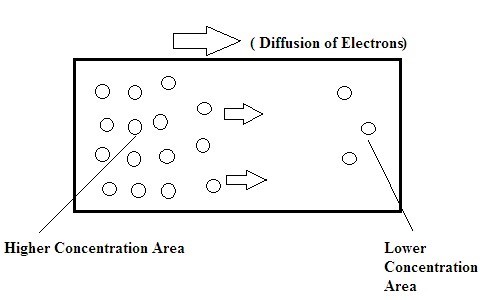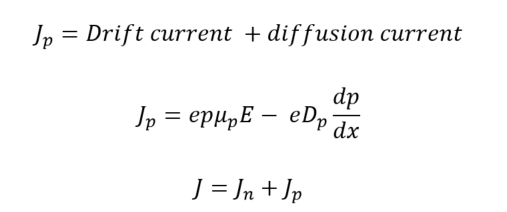Diffusion current is mainly generated in semiconductors.The doping done in the semiconductors is non-uniform. In order to achieve uniformity, the flow of charge carriers takes place from higher concentration area to lower concentration area. It is referred to as diffusion.
This process generally doesn’t occur in conductors. Fick’s law well describes the diffusion of flux from that the thesis is derived for the diffusion of electrons as well as for holes.
The necessity of the diffusion current in the semiconductor is because of the reason behind the dominating current at the junction. At the equilibrium condition, the net currents are zero because the forward current is balanced by the reverse drift current but inside the depletion region, both drift and diffusion currents are present.
What do you mean by Diffusion Current?
Generally in semiconductors, one can find the movement of charge carriers. This movement of the carriers is termed as Diffusion. The movement of carriers is observed from the higher concentration area to the lower concentration area.
In this process of movement, there is some generation of the current. This type of current is referred to as Diffusion Current for the semiconductors.
Diagram
Diffusion current can occur in the semiconductors that are non- uniformly doped because in non- uniformity only one can find the majority and the minority concentration so that movement can be observed for the carriers from higher concentration to the lower concentration.
Let us take the example of n-type semiconductor that doped non-uniformly. In this, the majority of the concentration of carriers is of electrons and the minority of the concentration of carriers is of holes. But while dealing with diffusion the property of majority carriers is considered here.
Once the movement of electrons is from higher concentration area to lower concentration area recombination takes place and it achieves uniformity and the current is generated in this process.

If it is n-type electrons move from higher concentration to lower concentration and in case if it is p-type holes tends to move from higher concentration area to lower concentration area. Drift and diffusion both the process occur in semiconductors but diffusion mainly occurs without the interference of external voltage.
Concentration Gradient
In any semiconductor, there is the presence of the concentration of electrons or holes. The difference in this concentration of electrons or holes is referred to as a concentration gradient. Diffusion current density is proportional to the concentration gradient.
If the value of the concentration gradient is high then the density will be high. If concentration gradient value is low in that case diffusion density will also be low.
Equations in between concentration gradients and the densities can be written as
(1) The equation for diffusion current density and concentration gradient of the n-type semiconductor

(2) The equation for diffusion current density and concentration gradient of the p-type semiconductor

Here represents the density with respect to electrons and represents the density with respect to holes.
Diffusion Current Density Equation
The diffusion density because of the carrier concentration of electrons is given by

Similarly, the diffusion density because of the carrier concentration of holes can be written as

Here stands for the diffusion coefficient with respect to electrons and stands for the diffusion coefficient with respect to holes.
The above equation is for the densities of diffusion densities with respect to electrons and holes but the overall density of the current of respective holes or electrons can be given by the sum of the diffusion current and the drift current.
The overall diffusion density with respect to electrons can be given as

The overall diffusion density with respect to holes can be given by the equations for the individual densities of electrons as well as holes. Therefore the overall current density can be given by

In this way, the equations for the diffusion current densities are described for holes as well as electrons. The diffusion current in the semiconductor has occurred before the application of external supply. It is also termed as the process of recombination in order to achieve uniformity. But have you ever thought why the diffusion doesn’t take place in conductors?